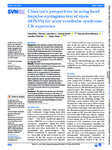Clinician’s perspectives in using Head Impulse-Nystagmus-Test of Skew for Acute Vestibular Syndrome: UK experience
| dc.contributor.author | Warner, CL | |
| dc.contributor.author | Bunn, Lisa | |
| dc.contributor.author | Koohi, N | |
| dc.contributor.author | KANG, JUNGHEE | |
| dc.contributor.author | Freeman, Jennifer | |
| dc.contributor.author | Kaski, D | |
| dc.date.accessioned | 2021-10-27T16:26:39Z | |
| dc.date.issued | 2021-10-26 | |
| dc.identifier.issn | 2059-8688 | |
| dc.identifier.issn | 2059-8696 | |
| dc.identifier.uri | http://hdl.handle.net/10026.1/18182 | |
| dc.description.abstract |
<jats:sec><jats:title>Background</jats:title><jats:p>Acute vestibular syndrome (AVS) features continuous dizziness and may result from a benign inner ear disorder or stroke. The head impulse-nystagmus-test of skew (HINTS) bedside assessment is more sensitive than brain MRI in identifying stroke as the cause of AVS within the first 24 hours. Clinicians’ perspectives of the test in UK secondary care remains unknown. Here, we explore front-line clinicians’ perspectives of use of the HINTS for the diagnosis of AVS.</jats:p></jats:sec><jats:sec><jats:title>Methods</jats:title><jats:p>Clinicians from two large UK hospitals who assess AVS patients completed a short online survey, newly designed with closed and open questions.</jats:p></jats:sec><jats:sec><jats:title>Results</jats:title><jats:p>Almost half of 73 total responders reported limited (n=33), or no experience (n=19), reflected in low rates of use of HINTS (n=31). While recognising the potential utility of HINTS, many reported concerns about subjectivity, need for specialist skills and poor patient compliance. No clinicians reported high levels of confidence in performing HINTS, with 98% identifying training needs. A lack of formalised training was associated with onward specialist referrals and neuroimaging (p=0.044).</jats:p></jats:sec><jats:sec><jats:title>Conclusions</jats:title><jats:p>Although the low sample size in this study limits the generalisability of findings to wider sites, our preliminary data identified barriers to the application of the HINTS in AVS patients and training needs to improve rapid, cost-effective and accurate clinical diagnosis of stroke presenting with vertigo.</jats:p></jats:sec> | |
| dc.format.extent | 172-175 | |
| dc.format.medium | Print-Electronic | |
| dc.language | en | |
| dc.language.iso | en | |
| dc.publisher | BMJ | |
| dc.subject | stroke | |
| dc.title | Clinician’s perspectives in using Head Impulse-Nystagmus-Test of Skew for Acute Vestibular Syndrome: UK experience | |
| dc.type | journal-article | |
| dc.type | Journal Article | |
| plymouth.author-url | https://www.webofscience.com/api/gateway?GWVersion=2&SrcApp=PARTNER_APP&SrcAuth=LinksAMR&KeyUT=WOS:000726778800001&DestLinkType=FullRecord&DestApp=ALL_WOS&UsrCustomerID=11bb513d99f797142bcfeffcc58ea008 | |
| plymouth.issue | 2 | |
| plymouth.volume | 7 | |
| plymouth.publication-status | Published | |
| plymouth.journal | Stroke and Vascular Neurology | |
| dc.identifier.doi | 10.1136/svn-2021-001229 | |
| plymouth.organisational-group | /Plymouth | |
| plymouth.organisational-group | /Plymouth/Faculty of Health | |
| plymouth.organisational-group | /Plymouth/Faculty of Health/School of Health Professions | |
| plymouth.organisational-group | /Plymouth/REF 2021 Researchers by UoA | |
| plymouth.organisational-group | /Plymouth/REF 2021 Researchers by UoA/UoA03 Allied Health Professions, Dentistry, Nursing and Pharmacy | |
| plymouth.organisational-group | /Plymouth/Research Groups | |
| plymouth.organisational-group | /Plymouth/Research Groups/Institute of Health and Community | |
| plymouth.organisational-group | /Plymouth/Research Groups/Plymouth Institute of Health and Care Research (PIHR) | |
| plymouth.organisational-group | /Plymouth/Users by role | |
| plymouth.organisational-group | /Plymouth/Users by role/Academics | |
| plymouth.organisational-group | /Plymouth/Users by role/Researchers in ResearchFish submission | |
| dc.publisher.place | England | |
| dcterms.dateAccepted | 2021-08-22 | |
| dc.rights.embargodate | 2021-10-30 | |
| dc.identifier.eissn | 2059-8696 | |
| dc.rights.embargoperiod | Not known | |
| rioxxterms.versionofrecord | 10.1136/svn-2021-001229 | |
| rioxxterms.licenseref.uri | http://www.rioxx.net/licenses/all-rights-reserved | |
| rioxxterms.licenseref.startdate | 2021-10-26 | |
| rioxxterms.type | Journal Article/Review |


